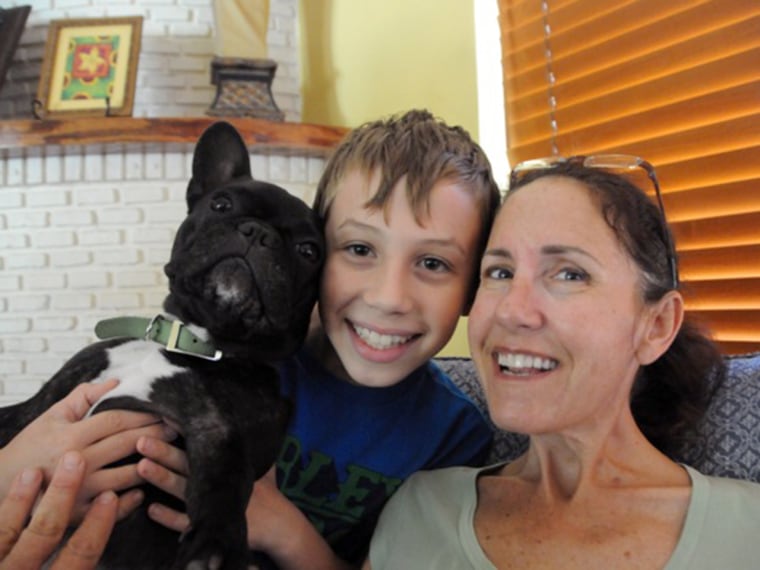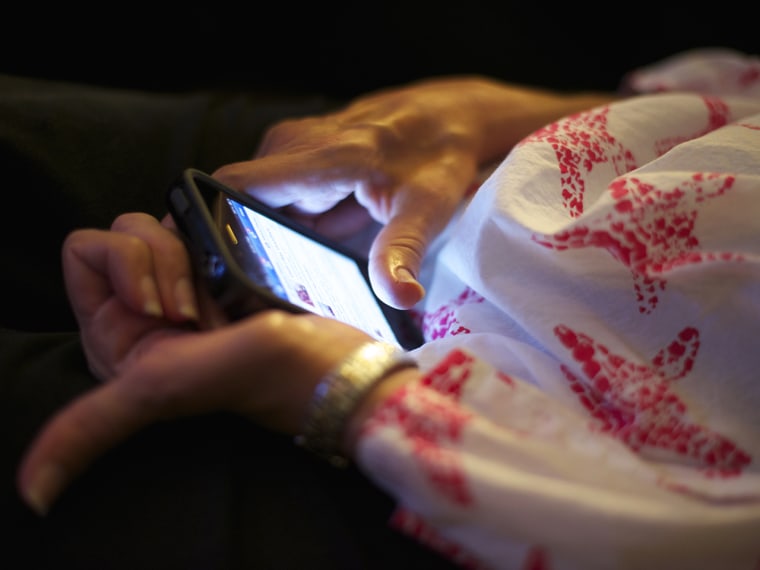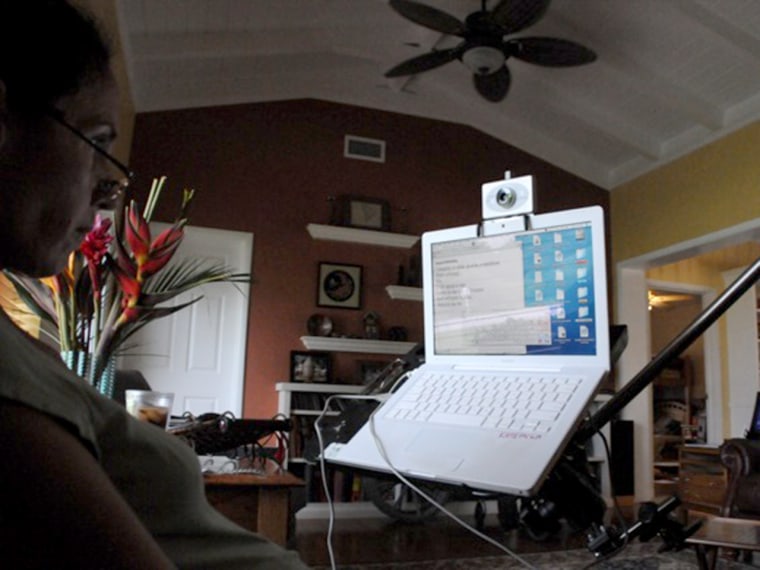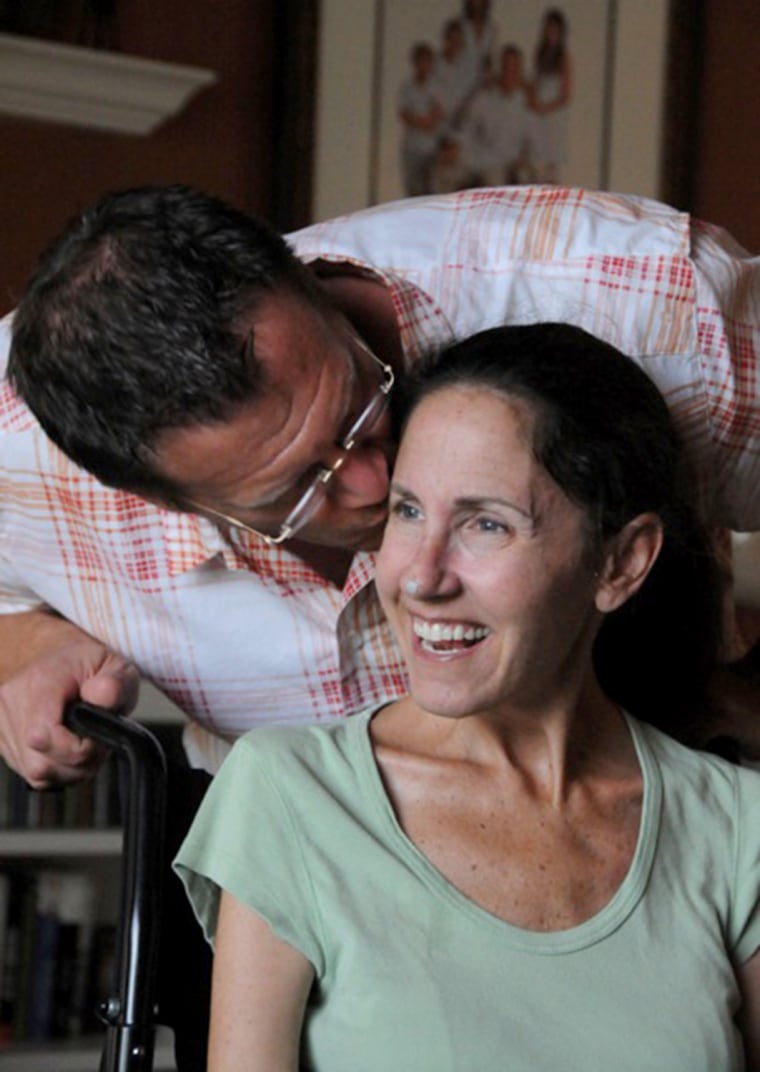Editor’s note: In case anyone needed evidence that Susan Spencer-Wendel is unstoppable, consider this: When she lost her mobility to Lou Gehrig’s disease, the longtime journalist used her right thumb to write a 357-page memoir on her iPhone.
Today, Susan, 46, can no longer control her thumb, and the writing process has become more arduous for her than ever — but the unconditional love of a dog can inspire great feats. In this case, Susan’s French bulldog Lenny motivated her to use a tool called the HeadMouse Extreme to write this essay for TODAY.com.
During the glut of publicity earlier this year about my book "Until I Say Goodbye" — crazy, wasn't it? — there entered another central character in my life, a perfect foil, which every good story needs.
Foil is a literary term meaning to present a character in contrast with another or in comparison. Hamlet dueled with his foil, Laertes.
Sherlock Holmes is challenged by his foil, Dr. Watson. Bert is annoyed by his foil, Ernie.
And I am complemented by my furry foil, a French bulldog named Lenny.
Lenny is the essence of delight, while I am a sad sight.
I was diagnosed with ALS (Lou Gehrig's disease) two years ago. My limbs are mostly paralyzed now, useless skinny spindles.
And there's Lenny beside me, a small dog but muscular like a bodybuilder. Thick shoulders, haunches, head. Slim hips.
Lenny's haunches spring him from a standstill on the ground up to my hospital bed in one leap.
I am in the care of Hospice now at my home. Ergo, we have all kinds of freaky equipment around, like a contraption people can use to lift me.
It has chains — CHAINS! And my new tricked-out bed makes all kind of eerie noises as the air mattress rotates pressure.
Read an excerpt from 'Until I Say Good-Bye: My Year of Living with Joy'
Hospice brought an old black wheelchair with straps to tie down my floppy limbs and head. As my daughter Marina, 15, keenly observed, "It looks like the electric chair."
This is all scary, scary stuff for children.
I often lie on my side with my knees bent. Lenny springs onto the bed and nestles behind my knees, then props his big ol' head on top of my knees and peers out.
Lenny has bug eyes, and it seems as if someone folded his jowls in pleats and then stapled his nose on top. It is so smashed in, his nose is nearly concave. And his bat ears stick straight up.
That is what the children see when they enter my room — that delightful little face peering out. They invariably squeal "LENNY!" and pick him up and cradle him.
In January, right about the time I could no longer eat solid food, I asked for a lapdog. My mother-in-law was visiting and said, "This may be none of my business, but why would you want a second dog at this time?"
"You're right," I struggled to say, my speech already badly slurred.
"It's none of your business."
Janet Wendel laughed, but I was serious. If I had to sit in a wheelchair mute, paralyzed and starving, I wanted a companion on my lap.
And I knew what kind: a small dog with a big dog personality, a French bulldog.
There seems to me to be no middle ground with French bulldogs: either you think they are adorable or butt-ugly. My friend Nancy upon first sight of one said, "It's kinda like looking at an ass."
Hubby John says Lenny looks like he escaped from Area 51.
I think they are adorable. I used to return to a certain dog park over and over to catch a glimpse of a Frenchie named Winston who went there.
Gracie, our 55-pound hound mix, loved to pal around with Winston, so I knew she'd enjoy a sibling.
Marina searched area dog shelters until she found a Frenchie. We named him Leonard after a friend of ours, a bodybuilder.
My foil Lenny is 18 pounds of muscle and head. He is black with a white chest and white dots behind each of his front paws.
He is the calmest member of the household, at times standing staring at a wall. The children will throw a blanket on top of him, and he remains just standing there.
Lenny joins us on many outings. I love to take him everywhere. He makes people smile.

We took him to the ceremony when the town where I live, Lake Clarke Shores, Florida, kindly awarded me a key to the town. Lenny was more quiet than my son Wesley, 9, who kept asking what the key opened.
Lenny stays beside us or on my lap. He will stand or sit on me in my wheelchair (not the electric chair — I refuse!). I like it when he raises up and props his front paws on the armrest. Then I can lean my head on him.
Right now as I sit in an armchair and type this, Lenny is sound asleep atop my right arm. That concave nose of his produces all kind of snurgles and snores.
When he inhales: "Sknnnnx."
And exhales: "Zzzzzzz."
Eighteen pounds on my arm is pulling me over to the right, but I would not ask someone to move him for love or money.

He is pinning down my right thumb, the one I typed my book with, reminding me I have to move on, learn to type another way.
This has been the worst struggle yet.
Imagine being an artist who paints in oil and one day all your paints are replaced with motor oil. Or a mechanic whose tools are replaced with gardening equipment.
So it was with me and my keyboard. I lost my laptop keyboard when ALS took my hands. Then I lost the one on my iPhone when my thumb went kerplewy.
I got a new keyboard, but it was so very much harder. At first, I tried a machine that read the retina of my eye. When my eyes dwelled upon a letter on the keyboard on the screen, it would type the letter.
It was a struggle to even align my eyeballs with the machine.
Most days I slept till 3 or 4 p.m., having no reason to get up.
Until serendipity struck again, and my sister Stephanie bumped into an angel.
She was lost on campus at University of Florida, and looking around trying to find her way, when a stranger rode up on his bike and offered directions. The man was John Schert, a faculty member. Schert's wife, Debby, died of ALS in 2010.
As Schert escorted Stephanie to her location, they passed UF's journalism school. And Steph — as she does everywhere she goes — bragged she has a sister, a grad of that school, who wrote a bestseller.
"Is she Susan Spencer-Wendel?" Schert asked, knowing well my story.
Steph told him how I was struggling with the eye-gaze computer.

Schert said his wife Debby had as well. "I know exactly what Susan should use," he said.
And exactly one week later, Schert was standing in my living room showing me.
It's a camera attached to the screen of my beloved laptop. John puts a reflective dot on my nose which the camera reads. There's a keyboard on the screen. I move the cursor over letters (and all over the screen) by bobbing my nose around like Stevie Wonder. (Stephanie says she feels seasick just watching me.) It is H-Y-P-E-R-T-E-D-I-O-U-S.
But much better than that goddamned eye-gaze machine — which, by the way, cost $17,000. And, by the way, if you are disabled yet can move your head a smidge, do not buy one under any circumstance.
I get crazy frustrated. Typing this way is soooooooooooo S-L-O-W. Then I try to move text around and delete five sentences it took me a half-hour to write.
My heart races, and I cry. I think, "How can I collect myself?"
Then I listen for it:
On the inhale: "Sknnnnx."
On the exhale" Zzzzzzz."
My little Lenny breathing so slowly. I count a full four seconds between his breaths. And I slow mine to match.
The muscles in my mouth have weakened so I cannot talk or eat well. I choke. I slur. John recognizes what I'm saying only because he's heard the cadence of the phrases so many times before: "Rub my eyes please." "I love you." And "I have a wedgie."
Feeding me my soupy meals is a messy affair with all kind of drips and dribbles. Lenny's also my right-hand man at mealtime. John calls "Lenny, come here. Clean-up on aisle one."
Lenny springs up on the sofa beside me and licks up the many stray drops.
I love to watch the Food Network while I eat runny mashed potatoes, particularly a show called "Diners, Drive-ins and Dives." In it, host Guy Fieri visits joints all over America sampling an inordinate number of oversized meat sandwiches.
Fieri hunches over as the chef looks on, opens his mouth wide as the grill and stuffs the sandwich in with absolute glee.
The Food Network stars are selected for their ability to cook but also for their ability to narrate tastes. Fieri does this well.
He'll lick his fingers and exclaim with his mouth full: "That puts the shammajama in the ding-dong!"
Watching Fieri and the cooks prepare and delight in the food helps satiate me and still enjoy food though I cannot eat.
I really like going to fine restaurants (and I still tell people what to order). Any restaurant really. I watch my friends enjoy while I have a cocktail, something festive like a Chambord Kir Royale. That's Champagne with a splash of the raspberry liqueur Chambord. It's so much easier for me to drink bubbly things. (Big smile.)
And though I can't walk or stand unassisted, I enjoy dancing.
The other night John and I were out, and we passed a club which had a live band playing salsa. The dance floor was packed. I asked to go in.
John and I watched the lovely Latin men and women gliding and turning to the beat, the rhythm an extension of themselves. And as always I enjoyed watching, a tad relieved I did not have to dance myself.
‘Cause truth be told, I wasn't a good dancer. I remember feeling so self-conscious. I saw a movie decades ago in which Billy Crystal's character poked fun of how when white people dance they jut their upper teeth forward. "White Man's Overbite," he called it.
Well, I would always catch myself doing the White Man's Overbite.
Then, I'd feel even more self-conscious.

These days, I enjoy things vicariously. Including watching people cradle Lenny and stroke his white chest.
Yes, we love us some dogs here at the Wendels. I commissioned an artist to paint them, an artist once honored by President Obama for his extraordinary talent. A.J. Brockman captured the glint in their eyes and on their noses, so much so I wanted to pet the canvas.
I was struck by how serious Lenny looks in his portrait, as we think of him as such a comical fellow. Then I realized that's indicative of my whole situation — one so serious yet we laugh and laugh. Another perfect complement.
I search for a deeper meaning in most everything.
I ponder at length my belief that desire is a root of suffering. I watch people eat, dance and pet my dog trying not to want to do so myself.
That is a Buddhist philosophy, that desire is a root of suffering.
I have also come to view my book in the light of another Buddhist concept: the mandala.
Tibetan monks and nuns create mandalas of colored sand, large circles with a kaleidoscope of design. They labor over it, funneling sand in intricate sweeps and swirls.
And then they sweep all the sand away and pour it into a river.
The circle signifies the cycle of life, and its erasure signifies the impermanence of all things.

I labored arranging those 89,000 words in my book just so. Then it was over — my work gone from me and carried far away, a message in itself.
I do not ask my agent or the Hollywood producer about their work turning my book into a movie. They must have the will to get it done independent of me.
And, besides, that is so far afield of what I can control.
I concentrate on what I can control: my mind.
I find it helpful to focus on space and nature and the remarkable things found there. I'd like to leave you, kind reader, with a story of a creature that captivated me (aside from Lenny).
The golden jellyfish.
They are found in one place on Earth, an island in the Pacific Ocean called Palau. They live in a lake there. Each day, thousands of golden jellyfish migrate across the lake in perfect symmetry with the arc of the sun. The golden jellyfish have an algae on their underside, which uses light to photosynthesize and feed its host.
The wee golden jellyfish glide along in silent, perfect symbiosis with the algae and in perfect synchronicity with the sun.
I think of them often as I sit with my furry foil Lenny. I think of how nature perfectly paired us.
And how sunsets, though an ending, are sublime.